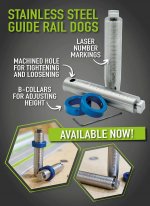Mark Katz
Member
Just got an email on this. What the heck are they used for? Can't think of a need to have precision markings and collar on a dog. No video on the site except for a TikTok that shows nothing that I can see. It seems the markings determine the height of the guide rail above the work surface.
Am I missing something obvious? I've added the image from the email as the website has no pictures of this device.
https://benchdogs.co.uk/products/gu...525&utm_medium=email&utm_source=shopify_email
[attachimg=1]
Am I missing something obvious? I've added the image from the email as the website has no pictures of this device.
https://benchdogs.co.uk/products/gu...525&utm_medium=email&utm_source=shopify_email
[attachimg=1]

